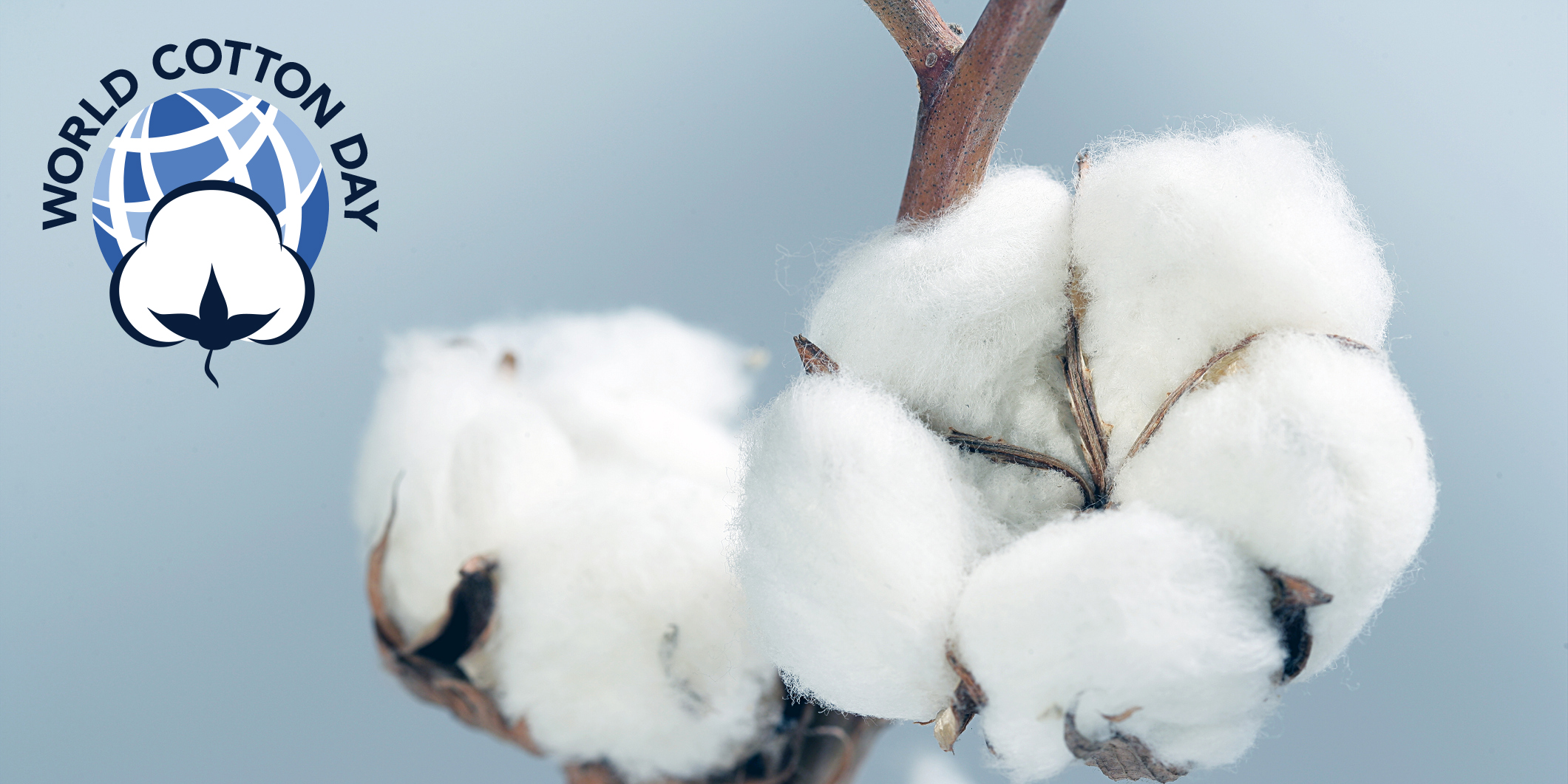This October 7 will mark the official United Nations (U.N.) World Cotton Day, when this humble plant and fiber is acknowledged not just for the fabric it brings to the world but for the millions of jobs it provides, the role it plays in sustainable and inclusive economic development, as well its many secondary uses.
Almost nothing from cotton is wasted. It is used in textiles, animal feed, edible oils, cosmetics and fuel, among other uses.”
World Cotton Day
United Nations
Cotton is naturally woven or knitted into a wide range of fabrics like velvet, corduroy, jersey, and flannel – many of the fabrics that will be seen in upcoming holiday apparel and home gift offerings. But instead of purely focusing on cotton’s role in fashion and home products, the U.N. also aims to raise visibility of the cotton sector and awareness of its function in international trade and poverty alleviation. The organization notes that cotton is a durable crop, resistant to climate changes, meaning it can be planted in dry and arid zones.
“Cotton occupies just 2.1 percent of the world’s arable land, yet it meets 27 percent of the world’s textile needs,” the U.N. states. “Almost nothing from cotton is wasted. It is used in textiles, animal feed, edible oils, cosmetics and fuel, among other uses.”
World Cotton Day was originally conceived in 2019 when four sub-Saharan African cotton producing countries – Benin, Burkina Faso, Chad, and Mali – proposed the idea to the World Trade Organization. For two years, the date represented an opportunity to share knowledge and highlight cotton-related activities. Now that the U.N. is involved, the international observance allows for awareness regarding the need for market access for cotton and cotton-related products from least-developed countries, fostering sustainable trade policies and enabling developing countries to benefit more from every step of the cotton value chain.
The Food and Agriculture Organization (FAO) has also been working with developing countries on methods to boost productivity and create more opportunities through initiatives like the +Cotton project, an enterprise with Brazil that helps Latin American cotton producers introduce innovative farming methods. The +Cotton project promotes sustainable and inclusive production, and encourages rural development. The idea is that government, extension workers, researchers, academics, farmers unions, and the textile sector work together to boost cotton production, promote technological innovations and expand marketing for the fiber and products made from it. The end goals include contributing to food security, eradicating rural poverty and hunger, and promoting gender equality and the autonomy of women farmers, economic growth, responsible production, and consumption.
The United States plays a major role in the global cotton market, as it is the third-largest producer of cotton globally, and a key producer and exporter of the fiber. The U.S. has produced about 35 percent of global cotton exports in recent years. The U.S. Department of Agriculture reports the country’s farmers produced nearly 20 million bales of cotton in the marketing year August 2019-July 2020, representing about $7 billion in total value. One bale of cotton – about 480 pounds of cleaned cotton lint – can produce more than 200 pairs of jeans or 1,200 T-shirts. And Upland cotton accounts for the vast majority of production.
Besides apparel, Upland cotton is used for home goods like curtains, bedding and upholstery, hospital and medical supplies, feminine hygiene products, and cleansing wipes, among other things.
Upland cotton can also be used for natural, unbleached cotton products. Here the fiber is mechanically cleaned with no water, chemicals, or heat. It is highly absorbent with low amounts of surfactant present and consumers prefer the soft, comfortable, and hypoallergenic qualities. For instance, natural, unbleached cotton can be employed as an affordable option for a variety of wipes. Consumers show an overall high regard for cotton, saying they believe wipes made with cotton would perform better on all purchase drivers than wipes made of synthetic fibers. In particular, they note cotton’s sustainability, as a majority say cotton wipes would perform better since they are made of natural materials (54 percent), environmentally-friendly (53 percent), and compostable or biodegradable (49 percent), according to the Cotton Incorporated 2022 Global Wipes Survey.
This preference for cotton continues to products for women and babies. Again, the majority of consumers (66 percent) say they prefer baby diapers and wipes to be made of cotton, according to the Cotton Incorporated 2018 Global Baby Care Survey. Most consumers (71 percent) are “very interested” in diapers that contain cotton, and 68 percent are “very interested” in wipes that contain cotton. Additionally, the majority of consumers believe cotton is best for their feminine hygiene products because it “safest for my body” (61 percent), “non-toxic” (60 percent), and “hypoallergenic” (60 percent), according to the Cotton Incorporated 2020 Global Feminine Hygiene Survey.

Of course, cotton is used for virtually every clothing category, and clothes are consistently a top holiday present, with about half of all holiday shoppers planning to give apparel as a gift, according to 2022 Cotton Incorporated Lifestyle Monitor™ Survey research. And most clothing gift givers will be looking for cotton-rich apparel gifts this season.
That’s good news for cotton farmers and producers everywhere. As the U.N. points out on World Cotton Day, while cotton is important to developed economies, it’s a safety net for the least-developed and developing countries.
“Let’s keep working on offering the assistance to the cotton sector in developing countries to keep increasing productivity and investment,” the U.N. states, “and bring innovation and sustainable standards to increase the benefits of the cotton sector worldwide.”
